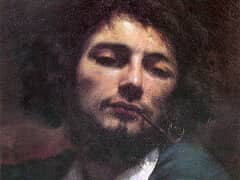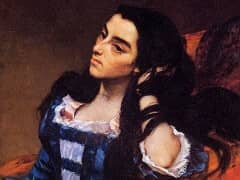The Wounded Man, 1844 by Gustave Courbet

Self-portraits occupied a central place in Gustave Courbet's youthful works. They were aesthetic and moral statements in which Courbet both claimed the heritage of the old Masters, the Dutch and Venetians in particular and indulged in romantic dramatisation.
In 1854, already taking a retrospective look at his oeuvre, Courbet wrote to Alfred Bruyas, his patron in Montpellier:
During my life, I have painted myself many times, whenever my state of mind changed. In short, I have written the story of my life".
The Wounded Man subscribes to this subjectivity by investing the romantic theme of the artist made heroic by suffering. The picture painted in 1844 was reworked by Courbet ten years later, at the end of a love affair. The woman, who was originally leaning on the artist's shoulder, has been replaced by a sword and Courbet has added a red bloodstain on his shirt over his heart. The artist has ambiguously and seductively combined the most intimate autobiographical register (by evoking a duel) with a death struggle confused with the sensual abandonment of sleep.















